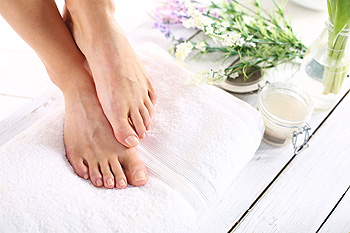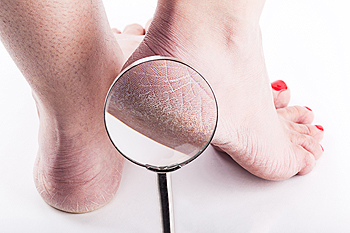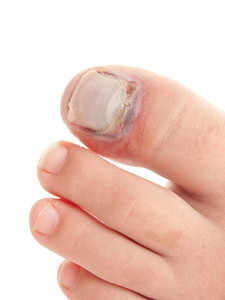
Drexel Hill (484) 521-0233
West Chester (610) 436-5883

Drexel Hill (484) 521-0233
West Chester (610) 436-5883
 If you experience itchy feet and toes, you may have what is referred to as athlete’s foot. This condition is caused by a fungus, and it thrives in moist environments, such as the inside of shoes and socks. Common places for this contagious condition to spread include public pools and showers, and it’s suggested to wear appropriate shoes while in these areas. Affected skin may appear to be dry, red, and cracked, which can lead to severe itching and may potentially cause discharge to ooze from affected areas. Proper treatment can consist of using an anti-fungal powder after thoroughly washing and drying the feet, especially between the toes. Consult with a podiatrist for additional information about athlete’s foot.
If you experience itchy feet and toes, you may have what is referred to as athlete’s foot. This condition is caused by a fungus, and it thrives in moist environments, such as the inside of shoes and socks. Common places for this contagious condition to spread include public pools and showers, and it’s suggested to wear appropriate shoes while in these areas. Affected skin may appear to be dry, red, and cracked, which can lead to severe itching and may potentially cause discharge to ooze from affected areas. Proper treatment can consist of using an anti-fungal powder after thoroughly washing and drying the feet, especially between the toes. Consult with a podiatrist for additional information about athlete’s foot.
Athlete’s Foot
Athlete’s foot is often an uncomfortable condition to experience. Thankfully, podiatrists specialize in treating athlete’s foot and offer the best treatment options. If you have any questions about athlete’s foot, consult with the podiatrists from Dr. Siegerman & Associates. Our doctors will assess your condition and provide you with quality treatment.
What Is Athlete’s Foot?
Tinea pedis, more commonly known as athlete’s foot, is a non-serious and common fungal infection of the foot. Athlete’s foot is contagious and can be contracted by touching someone who has it or infected surfaces. The most common places contaminated by it are public showers, locker rooms, and swimming pools. Once contracted, it grows on feet that are left inside moist, dark, and warm shoes and socks.
Prevention
The most effective ways to prevent athlete’s foot include:
Symptoms
Athlete’s foot initially occurs as a rash between the toes. However, if left undiagnosed, it can spread to the sides and bottom of the feet, toenails, and if touched by hand, the hands themselves. Symptoms include:
Diagnosis and Treatment
Diagnosis is quick and easy. Skin samples will be taken and either viewed under a microscope or sent to a lab for testing. Sometimes, a podiatrist can diagnose it based on simply looking at it. Once confirmed, treatment options include oral and topical antifungal medications.
If you have any questions, please feel free to contact one of our offices located in Drexel Hill and West Chester, PA . We offer the newest diagnostic and treatment technologies for all your foot care needs.
 It has often been recognized that many conditions concerning the feet may be indicative of the overall health of the body. If muscle spasms in the feet are experienced, it may be a result of certain vitamin deficiencies, which may cause dehydration. Additionally, if the feet are generally cold for a majority of the time, health issues such as diabetes or anemia may be present. Swollen and tender feet may represent the body’s inability to properly circulate the blood. Gout, a form of arthritis, is an extremely painful condition that typically affects men. This ailment is often triggered by a buildup of uric acid crystals, caused by ingesting excessive alcohol or meat. A condition referred to as foot drop indicates difficulty in lifting the front of the foot. This may be a result of the body incurring nerve damage, possibly originating from a leg injury. It’s suggested to consult with a podiatrist if you are affected by any of these conditions.
It has often been recognized that many conditions concerning the feet may be indicative of the overall health of the body. If muscle spasms in the feet are experienced, it may be a result of certain vitamin deficiencies, which may cause dehydration. Additionally, if the feet are generally cold for a majority of the time, health issues such as diabetes or anemia may be present. Swollen and tender feet may represent the body’s inability to properly circulate the blood. Gout, a form of arthritis, is an extremely painful condition that typically affects men. This ailment is often triggered by a buildup of uric acid crystals, caused by ingesting excessive alcohol or meat. A condition referred to as foot drop indicates difficulty in lifting the front of the foot. This may be a result of the body incurring nerve damage, possibly originating from a leg injury. It’s suggested to consult with a podiatrist if you are affected by any of these conditions.
When dealing with systemic disease of the feet, it is extremely important to check the affected areas routinely so that any additional problems are caught quickly. If you have any concerns about your feet and ankles contact the podiatrists from Dr. Siegerman & Associates. Our doctors will assist you with all of your podiatric needs.
Systemic Diseases of the Feet
Systemic diseases affect the whole body, and symptoms usually are displayed in the feet. This condition can make a patient’s ability to walk unbearable. Systemic diseases include gout, diabetes mellitus, neurological disorders, and arthritis.
Gout – is caused by an excess of uric acid in the body. Common symptoms include pain, inflammation, and redness at the metatarsal/phalangeal joint of the base big toe. Gout can be treated by NSAIDs to relieve pain and inflammation, and other drugs that lower the acid levels in the body.
Diabetes mellitus – is an increase in the level of blood sugar that the body cannot counteract with its own insulin. Failure to produce enough insulin is a factor in Diabetes.
Diabetes of the Feet
Diabetic Neuropathy – may lead to damaged nerves and affect the feet through numbness and loss of sensation.
Peripheral Vascular Disease – can restrict the blood flow to the feet, and often times lead to amputation of the feet.
If you have any questions please feel free to contact one of our offices located in Drexel Hill and West Chester, PA . We offer the newest diagnostic and treatment technologies for all your foot and ankle needs.
 If you experience cracked heels, you may be aware of the discomfort this condition can cause. The skin is typically hard and dry on the heel of the foot, resulting in the development of fissures, or cracks. These breaks in the skin can be deep, possibly causing the onset of severe pain. There are several causes of cracked heels, and these may include standing on a hard surface for the majority of the day, choosing to wear shoes with thin soles, or if a particular style of walking is executed. Occasionally, there may be skin conditions that may contribute to the development of cracked heels and are often referred to as eczema or dermatitis. The benefits of utilizing a moisturizer regularly will not only aid in healing the skin, but will help the skin on the heels feel better. It’s advised to schedule a consultation with a podiatrist if you would like additional information on how to treat cracked heels.
If you experience cracked heels, you may be aware of the discomfort this condition can cause. The skin is typically hard and dry on the heel of the foot, resulting in the development of fissures, or cracks. These breaks in the skin can be deep, possibly causing the onset of severe pain. There are several causes of cracked heels, and these may include standing on a hard surface for the majority of the day, choosing to wear shoes with thin soles, or if a particular style of walking is executed. Occasionally, there may be skin conditions that may contribute to the development of cracked heels and are often referred to as eczema or dermatitis. The benefits of utilizing a moisturizer regularly will not only aid in healing the skin, but will help the skin on the heels feel better. It’s advised to schedule a consultation with a podiatrist if you would like additional information on how to treat cracked heels.
Cracked heels are unsightly and can cause further damage to your shoes and feet. If you have any concerns, contact the podiatrists from Dr. Siegerman & Associates. Our doctors can provide the care you need to keep you pain-free and on your feet.
Cracked Heels
Cracked heels appear unappealing and can make it harder for you walk around in sandals. Aside from looking unpleasant, cracked heels can also tear stockings, socks, and wear out your shoes. There are several methods to help restore a cracked heel and prevent further damage.
How Do You Get Them?
Dry skin is the number one culprit in creating cracked heels. Many athletes, walkers, joggers, and even swimmers suffer from cracked heels. Age and skin oil production play a role to getting cracked heels as well.
Promote Healing
Over the counter medicines can help, especially for those that need instant relief or who suffer from chronic dry feet.
Wear Socks – Wearing socks with medicated creams helps lock in moisture.
Moisturizers – Applying both day and night will help alleviate dryness which causes cracking.
Pumice Stones – These exfoliate and remove dead skin, which allows for smoother moisturizer application and better absorption into the skin.
Change in Diet
Eating healthy with a well-balanced diet will give the skin a fresh and radiant look. Your body responds to the kinds of food you ingest. Omega-3 fatty acids and zinc supplements can also revitalize skin tissue.
Most importantly, seek professional help if unsure how to proceed in treating cracked heels. A podiatrist will help you with any questions or information needed.
If you have any questions, please feel free to contact one of our offices located in Drexel Hill and West Chester, PA . We offer the newest diagnostic and treatment technologies for all your foot care needs.
 If you’ve dropped something heavy on your toe, and you begin to notice swelling and bruising, you may have what is referred to as a broken toe. Severe pain typically accompanies this injury, and walking may prove to be a difficult task to accomplish. If you stubbed your toe with extreme force, the toe will appear to be misaligned if the break is severe. Experiencing a broken toe can be easily managed as long as the skin is not broken or the toe is not out of alignment. This often includes resting and elevating your foot to attain relief. There may be symptoms that appear to accompany more serious fractures including numbness, the toe turning blue, and coldness when touched. It’s suggested to consult with a podiatrist for additional information and proper treatment options for a broken toe.
If you’ve dropped something heavy on your toe, and you begin to notice swelling and bruising, you may have what is referred to as a broken toe. Severe pain typically accompanies this injury, and walking may prove to be a difficult task to accomplish. If you stubbed your toe with extreme force, the toe will appear to be misaligned if the break is severe. Experiencing a broken toe can be easily managed as long as the skin is not broken or the toe is not out of alignment. This often includes resting and elevating your foot to attain relief. There may be symptoms that appear to accompany more serious fractures including numbness, the toe turning blue, and coldness when touched. It’s suggested to consult with a podiatrist for additional information and proper treatment options for a broken toe.
A broken toe can be very painful and lead to complications if not properly fixed. If you have any concerns about your feet, contact the podiatrists from Dr. Siegerman & Associates. Our doctors will treat your foot and ankle needs.
What to Know About a Broken Toe
Although most people try to avoid foot trauma such as banging, stubbing, or dropping heavy objects on their feet, the unfortunate fact is that it is a common occurrence. Given the fact that toes are positioned in front of the feet, they typically sustain the brunt of such trauma. When trauma occurs to a toe, the result can be a painful break (fracture).
Symptoms of a Broken Toe
Generally, it is best to stay off of the injured toe with the affected foot elevated.
Severe toe fractures may be treated with a splint, cast, and in some cases, minor surgery. Due to its position and the pressure it endures with daily activity, future complications can occur if the big toe is not properly treated.
If you have any questions please feel free to contact one of our offices located in Drexel Hill and West Chester, PA . We offer the newest diagnostic and treatment technologies for all your foot and ankle needs.
 There are several early signs that can indicate you may have toenail fungus. Such indicators may include the nails becoming thick and yellowed, and may crumble when touched. An infection is likely to develop if the nail is left untreated, allowing the fungus to grow. The aging process may be a factor in developing this ailment, in addition to having poor blood circulation. Medical conditions such as eczema, psoriasis, or athlete’s foot allow easier access for the fungus to enter the body through the tiny openings in the skin these conditions may cause. Toenail fungus lives in moist environments, and socks and shoes that are worn without proper ventilation make it ideal for this fungus to grow. There are several ways to prevent this condition from developing, and these may include trimming the nails straight across, wearing appropriate shoes in public showers or pools, and utilizing a moisturizer to prevent cracked skin. A consultation with a podiatrist is suggested for a complete diagnosis and possible treatment options that are right for you.
There are several early signs that can indicate you may have toenail fungus. Such indicators may include the nails becoming thick and yellowed, and may crumble when touched. An infection is likely to develop if the nail is left untreated, allowing the fungus to grow. The aging process may be a factor in developing this ailment, in addition to having poor blood circulation. Medical conditions such as eczema, psoriasis, or athlete’s foot allow easier access for the fungus to enter the body through the tiny openings in the skin these conditions may cause. Toenail fungus lives in moist environments, and socks and shoes that are worn without proper ventilation make it ideal for this fungus to grow. There are several ways to prevent this condition from developing, and these may include trimming the nails straight across, wearing appropriate shoes in public showers or pools, and utilizing a moisturizer to prevent cracked skin. A consultation with a podiatrist is suggested for a complete diagnosis and possible treatment options that are right for you.
For more information about treatment, contact the podiatrists of Dr. Siegerman & Associates. Our doctors can provide the care you need to keep you pain-free and on your feet.
Toenail Fungus Treatment
Toenail fungus is a condition that affects many people and can be especially hard to get rid of. Fortunately, there are several methods to go about treating and avoiding it.
Antifungals & Deterrence
Oral antifungal medicine has been shown to be effective in many cases. It is important to consult with a podiatrist to determine the proper regiment for you, or potentially explore other options.
Applying foot powder on the feet and shoes helps keep the feet free of moisture and sweat.
Sandals or open toed shoes – Wearing these will allow air movement and help keep feet dry. They also expose your feet to light, which fungus cannot tolerate. Socks with moisture wicking material also help as well.
If you have any questions please feel free to contact one of our offices located in Drexel Hill and West Chester, PA . We offer the newest diagnostic tools and technology to treat your foot and ankle needs.
Request a free copy of
Laser Away Foot Pain!
today.
